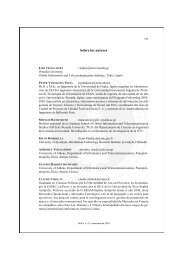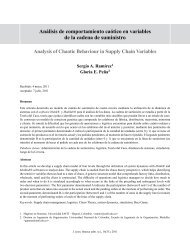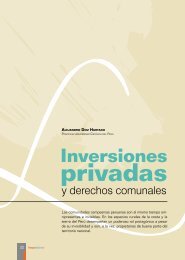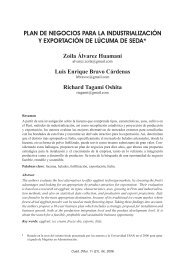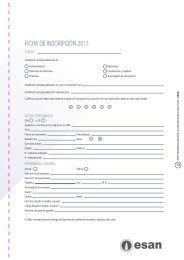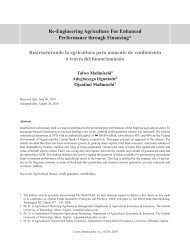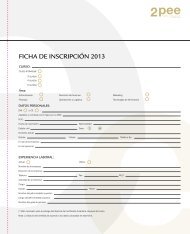El costo de capital en sectores regulados y mercados ... - Esan
El costo de capital en sectores regulados y mercados ... - Esan
El costo de capital en sectores regulados y mercados ... - Esan
You also want an ePaper? Increase the reach of your titles
YUMPU automatically turns print PDFs into web optimized ePapers that Google loves.
a stock listed on the Brazilian in<strong>de</strong>x was 60%. The relative volatility for Telebras can be<br />
estimated as follows:<br />
Note that the relative volatility is standardized around one; relative volatilities greater than<br />
one indicate above-average risk, while relative volatilites less than one indicate belowaverage<br />
risk. In addition, the average relative volatility across all stocks will average to one.<br />
Finally, the relative volatility is used in much the same way as the traditional beta estimate<br />
to compute expected returns:<br />
Expected Return = Riskfree Rate + Relative Volatility (Expected Risk Premium)<br />
What are the advantage of using relative volatility The term that creates the most noise in<br />
the traditional beta estimate is the estimate of correlation betwe<strong>en</strong> the asset and the<br />
market in<strong>de</strong>x. The relative volatility measure does not require a correlation measure and<br />
h<strong>en</strong>ce is less noisy. This comes with a cost, however. The relative volatility measure is<br />
based upon the assumption that total risk and market risk exposures are perfectly<br />
correlated. In other words, firms with high total risk will also be exposed to high market<br />
risk. Finally, <strong>de</strong>cisions ma<strong>de</strong> on how to compute the average standard <strong>de</strong>viation will affect<br />
relative volatility. Thus, the relative volatility of Telebras computed relative to the average<br />
Brazilian stock will be very differ<strong>en</strong>t from the relative volatility computed for Telebras using<br />
the ADR and the average standard <strong>de</strong>viation across stocks listed on the S&P 500.<br />
(Damodaran, 1998c:20-21)<br />
Cálculo <strong>de</strong>l retorno económico esperado <strong>en</strong> <strong>mercados</strong> emerg<strong>en</strong>tes<br />
Finalm<strong>en</strong>te po<strong>de</strong>mos calcular los retornos esperados <strong>en</strong> los <strong>mercados</strong><br />
emerg<strong>en</strong>tes según la sigui<strong>en</strong>te relación:<br />
K<br />
OA _ país emerg<strong>en</strong>te<br />
= K OA _ NYSE<br />
+<br />
23<br />
Prima por Riesgo País<br />
<strong>El</strong> COK sectorial NYSE es el resultado <strong>de</strong> la sigui<strong>en</strong>te fórmula:<br />
K<br />
OA _ sectorial<br />
= rf<br />
+ β<br />
OA _ sectorial<br />
×<br />
( R − r )<br />
3. Método II: Retorno esperado mediante los betas públicos<br />
<strong>de</strong> empresas reguladas<br />
3.1. Conceptos<br />
<strong>El</strong> método consiste <strong>en</strong> calcular el COK utilizando los datos públicos <strong>de</strong> la<br />
empresa. Si exist<strong>en</strong> datos sobre el beta y la relación D/C, se estará <strong>en</strong><br />
posibilida<strong>de</strong>s <strong>de</strong> <strong>en</strong>contrar el COK económico y financiero.<br />
Debe recordarse que el concepto <strong>de</strong>l COK es apropiado para una empresa<br />
específica u otra con riesgo similar. En el anterior método se ha <strong>en</strong>contrado<br />
una aproximación o cap <strong>de</strong>terminado por diversas empresas con riesgos<br />
negocios distintos, que <strong>en</strong> promedio dan los resultados anteriorm<strong>en</strong>te vistos,<br />
pero no significa que ése sea el COK <strong>de</strong> una empresa <strong>en</strong> particular.<br />
<strong>El</strong> método directo, que es el que se está analizando, se valida por el hecho <strong>de</strong><br />
que los parámetros han sido calculados por empresas <strong>de</strong> servicios <strong>de</strong><br />
información financiera que perman<strong>en</strong>tem<strong>en</strong>te están <strong>de</strong>terminando tasas para<br />
diversas empresas, <strong>en</strong> distintos <strong>mercados</strong>. Se aísla la subjetividad <strong>de</strong> los<br />
analistas, porque las metodologías son g<strong>en</strong>éricas.<br />
m<br />
f



